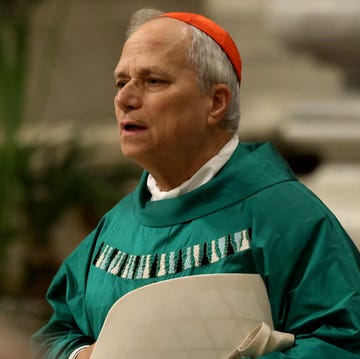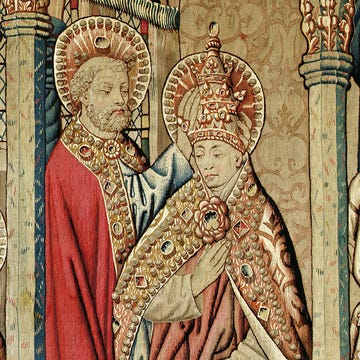Here’s what you’ll learn when you read this article:
- Five pieces of 1,300 year old Communion bread were discovered in Turkey.
- One loaf depicts Jesus sowing seeds, while the other four feature the Maltese cross.
- The loaves were preserved thanks to carbonization from a fire.
This story is a collaboration with Popular Mechanics.
Bread plays a vital role in the ritualistic side of Christian worship. Today, millions of Christians partake in the sacrament of Communion, placing a piece of bread—representing Jesus’ body in accordance with the gospels’ story of the Last Supper—on their tongues during a religious service. While the sacramental bread now comes in the form of small, mass-produced wafer, that wasn't always the case, especially not 1,300 years ago.
How do we know this? Well, because somebody found some of that 1,300-year-old bread.
According to a report from The Jerusalem Post, archaeologists excavating Topraktepe, Turkey discovered five loaves of bread, preserved through carbonization, which they dated back to either “the seventh or eighth century C.E.” An abrupt fire likely caused the carbonization which kept the loaves preserved for over a millennia, in a state local authorities called “among the best-preserved examples identified in Anatolia to date.”
Archaeologists were able to determine that this particular preserved bread had a religious, and specifically Christian, connotation, due to the images emblazoned on them. One loaf shows a depiction of Jesus scattering grains beneath the words “with our gratitude to Blessed Jesus” written in Greek. The other four loaves feature a Maltese cross—an eight-pointed cross symbol that once appeared on armor during the Crusades.
“These 1,300-year-old breads shed new light on a fascinating chapter of early Byzantine life,” a member of the excavation team remarked. “They prove that piety extended beyond prayers and ceremonies, materializing in objects that carried spiritual significance to the most basic human need: bread.”
That the bread depicts Jesus as sowing grain may hold two purposes. One could be to evoke the parable of the sower, a story relayed by Jesus in three of the four canonical gospels (Matthew chapter 13, Mark chapter 4, and Luke chapter 8) meant to convey the idea that preaching the gospels is like sowing seeds, in that only fertile soil will allow it to grow and thrive.
But it also could represent a contrast in how Jesus was worshipped in more rural areas, as opposed to in major cities like Constantinople. Since agriculture was central to the lives of the people worshipping here, depicting Jesus partaking in the same practices they did was a way to find deeper connection with the Christ figure, rather than purely as an object of ethereal divinity.
The archaeologists now plan to subject the loaves to “chemical and botanical analyses” to determine which grains and leavening agents were used to make the bread. They also hope to continue searching the area to locate the house of worship from which the bread may have originated.
Michale Natale is a News Editor for the Hearst Enthusiast Group. As a writer and researcher, he has produced written and audio-visual content for more than fifteen years, spanning historical periods from the dawn of early man to the Golden Age of Hollywood. His stories for the Enthusiast Group have involved coordinating with organizations like the National Parks Service and the Secret Service, and travelling to notable historical sites and archaeological digs, from excavations of America’ earliest colonies to the former homes of Edgar Allan Poe.













